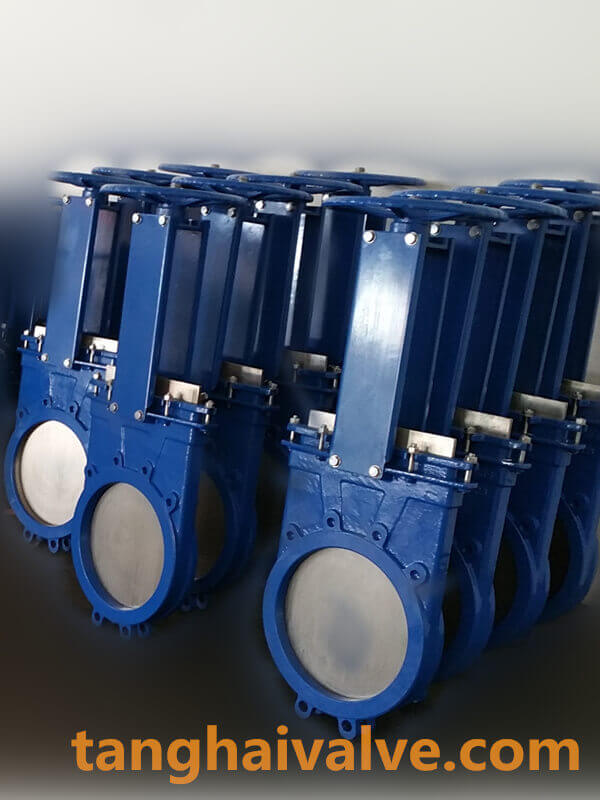Knife Gate Valve Structure and Working Principle
Knife gate valve, also called knife type gate valve, is a kind of gate valve. The structural feature of the knife gate valve is that there is an oblique cut at the bottom of its valve plate. Like a knife edge, this knife-shaped oblique cut can easily cut off the medium circulating in the pipeline, so that the valve can be closed without being blocked by the medium. Below is the structure diagram of the knife gate valve.

Knife gate valve (6)
Knife gate valves are generally used in medium pipelines such as pulp, slag, coal ash, sewage, and chemical raw materials. They can only be fully opened and fully closed. They are used as shut-off valves and cannot be used for flow regulation. The transmission modes of the knife gate valve are manual, pneumatic, electric, etc., and its working principle is also very simple. The following takes the manual knife gate valve as an example to introduce the working principle of the knife gate valve to you.
The working principle of the manual knife gate valve is to turn the handwheel by hand to make the valve stem rise or fall, thereby driving the gate to move up and down to achieve the purpose of opening or closing the valve. Turn the handwheel clockwise, the gate goes down, and the valve closes. Turn the handwheel counterclockwise, the gate rises, and the valve opens.
Compared with the traditional gate valve, the structure of the knife gate valve is simpler, the length and size are smaller, and it is easier to install, disassemble and maintain. Knife gate valves are suitable for use in medium pipelines with high consistency and solid particles. The gate like a guillotine has a better gate breaking effect, and can effectively cut off various impurities contained in the medium in the pipeline, completely solving the leakage phenomenon of the traditional gate valve after passing through the medium containing particulate impurities.
Knife gate valves have very short structural lengths and take up little space. The full-bore knife gate valve design allows the valve to be used in dirty media, and the replaceable seat and packing also make valve maintenance easier.
Although the performance of the knife gate valve is better than that of the traditional gate valve, the price of the knife gate valve is higher than that of the traditional gate valve, so the knife gate valve cannot completely replace the traditional gate valve at present.
Knife gate valve installation and use:
1. Before installation, check the valve cavity and sealing surface, and do not allow dirt or sand to adhere;
2. The bolts of each connecting part should be tightened evenly;
3. Check that the packing parts are required to be pressed tightly, not only to ensure the sealing of the packing, but also to ensure the flexible opening of the gate;
4. Before installing the valve, the user must check the valve model, connection size and pay attention to the flow direction of the medium to ensure the consistency with the valve requirements;
5. When installing the valve, the user must reserve the necessary space for the valve drive;
6. The wiring of the drive device must be carried out according to the circuit diagram;
7. The knife gate valve must be maintained regularly, and must not be collided and squeezed at will, so as not to affect the sealing.
TH Valve is a professional manufacturer of butterfly valve, gate valve, check valve, globe valve, knife gate valve, ball valve with API, JIS, DIN standard, used in Oil, Gas, Marine industry, Water supply and drainage, fire fighting, shipbuilding, water treatment and other systems, with Nominal Diameter of DN50 to DN1200, NBR/EPDM/VITON, Certificates & Approvals: DNV-GL, Lloyds, DNV, BV, API, ABS, CCS. Standards: EN 593, API609, API6D
Video of knife gate valve:
Related news/knowledge:
The difference between knife gate valve and ordinary gate valve
Characteristics of soft seal /resilient seated gate valves
What are the commonly used valves



 © Copyright 2020 Tianjin Tanghaidongyang Valve Co., Ltd. All Rights Reserved.
© Copyright 2020 Tianjin Tanghaidongyang Valve Co., Ltd. All Rights Reserved.